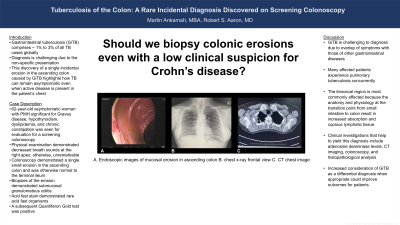Tuesday Poster Session
Category: Colon
P3807 - Tuberculosis of the Colon: A Rare Incidental Diagnosis Discovered on Screening Colonoscopy
Tuesday, October 29, 2024
10:30 AM - 4:00 PM ET
Location: Exhibit Hall E

Has Audio

Martin Ankamah, MBA
University of St. Thomas Houston
Houston, TX
Presenting Author(s)
Martin Ankamah, MBA1, Robert S.. Aaron, MD2
1University of St. Thomas Houston, Houston, TX; 2Allied Digestive Health (Middlesex Monmouth Gastroenterology), Freehold, NJ
Introduction: Extrapulmonary tuberculosis with gastrointestinal manifestations is rare, comprising 1% to 3% of all TB cases globally. These patients may present with abdominal pain, anorexia, fever, changes in bowl habits, nausea and vomiting, or melena. This diagnosis is challenging due to the non-specific presentation of gastrointestinal tuberculosis (GiTB). It can affect both immunocompromised and immunocompetent patients. Fortunately, many patients respond favorably to anti-tuberculosis medications. In this case report, the discovery of a single incidental erosion in the ascending colon caused by GiTB highlights how tuberculosis can remain asymptomatic, even in a patient with active disease in the chest.
Case Description/Methods: The patient is a 62-year-old asymptomatic woman with a past medical history significant for Graves disease, hypothyroidism, dyslipidemia, and chronic constipation who was seen in the office for evaluation for a screening colonoscopy. Physical examination demonstrated decreased breath sounds at the right apex but was otherwise unremarkable. Colonoscopy demonstrated a single small erosion in the ascending colon and was otherwise normal to the terminal ileum. Biopsies of the erosion demonstrated submucosal granulomatous colitis. Acid fast stain demonstrated rare acid fast organisms. A subsequent Quantiferon Gold test was positive.
Chest x-ray demonstrated a right apical opacity. CT chest demonstrated a 4 cm pleural based opacity in the right upper lobe with associated right upper lobe bronchiectasis and scattered irregular peripheral opacities in both upper lobes. A tree in bud appearance and diffuse increased reticular markings involving the right upper lobe were also noted, possibly due to endobronchial spread. Localized bronchiectasis was also seen in the right upper lobe.
Discussion: GiTB is challenging to diagnose due to overlap of symptoms with those of other gastrointestinal diseases. Many affected patients experience pulmonary tuberculosis concurrently. The ileocecal region is most commonly affected because the anatomy and physiology at the transition point from small intestine to colon result in increased absorption and copious lymphatic tissue. Clinical investigations that help to yield this diagnosis include adenosine deaminase levels, CT imaging, colonoscopy, and histopathological analysis. Increased consideration of GiTB as a differential diagnosis when appropriate could improve outcomes for patients.

Disclosures:
Martin Ankamah, MBA1, Robert S.. Aaron, MD2. P3807 - Tuberculosis of the Colon: A Rare Incidental Diagnosis Discovered on Screening Colonoscopy, ACG 2024 Annual Scientific Meeting Abstracts. Philadelphia, PA: American College of Gastroenterology.
1University of St. Thomas Houston, Houston, TX; 2Allied Digestive Health (Middlesex Monmouth Gastroenterology), Freehold, NJ
Introduction: Extrapulmonary tuberculosis with gastrointestinal manifestations is rare, comprising 1% to 3% of all TB cases globally. These patients may present with abdominal pain, anorexia, fever, changes in bowl habits, nausea and vomiting, or melena. This diagnosis is challenging due to the non-specific presentation of gastrointestinal tuberculosis (GiTB). It can affect both immunocompromised and immunocompetent patients. Fortunately, many patients respond favorably to anti-tuberculosis medications. In this case report, the discovery of a single incidental erosion in the ascending colon caused by GiTB highlights how tuberculosis can remain asymptomatic, even in a patient with active disease in the chest.
Case Description/Methods: The patient is a 62-year-old asymptomatic woman with a past medical history significant for Graves disease, hypothyroidism, dyslipidemia, and chronic constipation who was seen in the office for evaluation for a screening colonoscopy. Physical examination demonstrated decreased breath sounds at the right apex but was otherwise unremarkable. Colonoscopy demonstrated a single small erosion in the ascending colon and was otherwise normal to the terminal ileum. Biopsies of the erosion demonstrated submucosal granulomatous colitis. Acid fast stain demonstrated rare acid fast organisms. A subsequent Quantiferon Gold test was positive.
Chest x-ray demonstrated a right apical opacity. CT chest demonstrated a 4 cm pleural based opacity in the right upper lobe with associated right upper lobe bronchiectasis and scattered irregular peripheral opacities in both upper lobes. A tree in bud appearance and diffuse increased reticular markings involving the right upper lobe were also noted, possibly due to endobronchial spread. Localized bronchiectasis was also seen in the right upper lobe.
Discussion: GiTB is challenging to diagnose due to overlap of symptoms with those of other gastrointestinal diseases. Many affected patients experience pulmonary tuberculosis concurrently. The ileocecal region is most commonly affected because the anatomy and physiology at the transition point from small intestine to colon result in increased absorption and copious lymphatic tissue. Clinical investigations that help to yield this diagnosis include adenosine deaminase levels, CT imaging, colonoscopy, and histopathological analysis. Increased consideration of GiTB as a differential diagnosis when appropriate could improve outcomes for patients.

Figure: A. Endoscopic image of mucosal erosion in ascending colon B. chest x-ray frontal view C. CT chest image
Disclosures:
Martin Ankamah indicated no relevant financial relationships.
Robert Aaron indicated no relevant financial relationships.
Martin Ankamah, MBA1, Robert S.. Aaron, MD2. P3807 - Tuberculosis of the Colon: A Rare Incidental Diagnosis Discovered on Screening Colonoscopy, ACG 2024 Annual Scientific Meeting Abstracts. Philadelphia, PA: American College of Gastroenterology.

